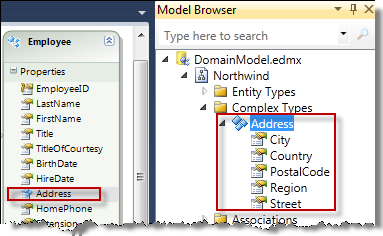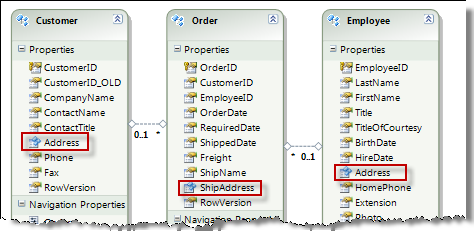A ComplexType is a class composed of other entity data properties.
The ComplexType
A ComplexType is a way to represent complex data within an entity.
Consider the Northwind "Employee" table for example. The "Employee" table has FirstName and LastName columns. These become simple data properties of the Employee entity.
The "Employee" table also has Address, City, Region, PostalCode and Country columns. In a default mapping, the Employee entity would have five corresponding properties.
But conceptually, these five properties are a single thing, an "address". We'd like to treat them as an Address object. We'd like to write anEmployee.Address and expect to get an Address object in return. We'd like to be able to create a new Address object and assign it to anEmployee.Address. We might add validation rules to the Address class that constrain the PostalCode to values that are legitimate for the Region.
The Address in this example is a ComplexType and you can create it in the Entity Framework's EDM Designer. Julie Lerman tells how in a blog post and Matthieu Mezil shows how in his video.
Here is the Northwind Employee entity with an Address property as seen in the EDM Designer:

It is not an entity
A ComplexType is not an entity. It doesn't map to a complete table row. It lacks a unique key. It has no existence independent from the entity to which it belongs. A ComplexType is called a "value type because it is entirely defined by the values it holds, in much the way that the number "5" is a value type. There is no table of numbers and no row representing the value "5". In this example there is no "Address" table either.
ComplexType reuse
As it happens, those same five address columns appear in two other Northwind database tables: "Customer" and "Order".
You can re-map their address columns to the Address type as seen in this screenshot:

ComplexType classes
DevForce generates ComplexType classes into your code file as it does the entity classes. The properties of the generated ComplexType classes are similar to generated entity properties and they support notification, validation, and property interception as their entity cousins do. The generated ComplexType classes are partial so you can extend them with custom logic as you do your entity classes.
An instance has a parent entity
A ComplexType instance doesn't stand alone; it belongs to its parent entity. For example, the Address of the "Nancy Davolio" Employee belongs to the "Nancy Davolio" Employee entity. In DevForce , you can always ask a ComplexType for its parent.
| C# | Assert.AreSame(nancy, nancy.Address.ComplexAspect.ParentEntity); |
| VB | Assert.AreSame(nancy, nancy.Address.ComplexAspect.ParentEntity) |
This "belonging" is a necessary consequence of a ComplexType. The City, Region, and other properties of "Nancy's" address actually map to columns on the "Nancy" record in the Employee table. There is no Address table in this case; only a subset of the Person table's columns that we want to treat as an address.
It follows also that a data property that returns a ComplexType cannot be null. It's member properties can be null - nancy.Address.City may be null. But the ComplexType data property itself - nancy.Address - cannot be null.
Learn more
Learn more about how to create and work with ComplexTypes in the EDM designer.

